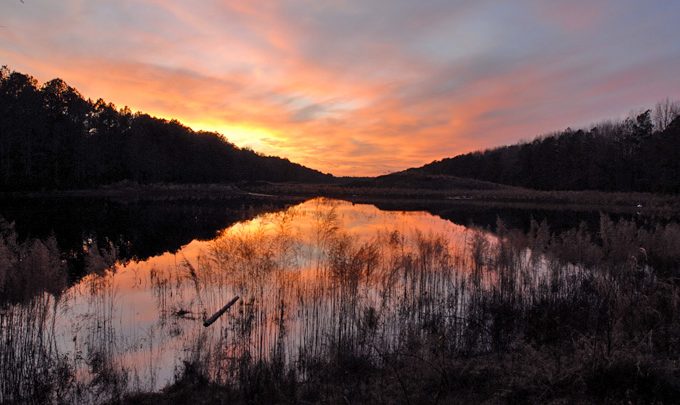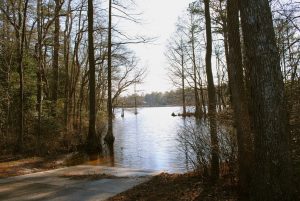
Delaware is known as The First State and The Diamond State. It is also known for its size, or lack thereof. There are 48 states that are larger than Delaware, and only Rhode Island is smaller. What Delaware lacks in size it makes up for in other ways. There are beaches, plenty of history, and the Delmarva Peninsula, which is one of the largest peninsulas in the Eastern United States. In Delaware, you can also find bald cypress trees. There are at least two fantastic places where you can see them. Here is what you need to know about these fascinating trees, and where you can see them for yourself.

What Is a Bald Cypress Tree?
At first glance, you might think that a bald cypress tree is a type of pine tree. After all, it has needles and it also bears cones. In fact, the bald cypress tree, or Taxodium Distichum, is a deciduous tree. While it does have leaves that look more like needles, it will shed its “needles” each winter, and new ones will grow in the spring. The “needles” will turn red or yellow in the fall, unlike the needles on pine trees.

More Facts
Bald cypress trees are known for both their height and their longevity. If healthy and left alone, they can grow to at least 35 feet, but it is possible for the trees to reach a height of 120 feet or more. The trees can also outlast pretty much everything around them, they are one of the longest living plants in North America. It is difficult to fully determine the age of a bald cypress because the trees become hollow as they age. There are some bald cypress trees that are believed to be almost 2,000 years old. The trees grow well in full sunlight or partial shade. They thrive in wet environments and do well with a small amount of salt water, which is why the Delmarva Peninsula provides the ideal environment for them.

Wood
The wood from bald cypress trees is resistant to rot. That makes it desirable for all kinds of different projects. The wood is considered ornamental as well because of the color and the patterns within it. Native Americans used the wood to make everything from coffins to canoes. The wood is also odorless, which makes it a popular choice for inside projects such as kitchen cabinets. Even though the wood is harvested in several places across the country, there is still nothing quite like seeing these unique trees growing in their natural habitat.

Trap Pond State Park
One of the best places to see bald cypress trees in the state of Delaware is Trap Pond State Park. This 3,653-acre park is located near Laurel, Delaware. The whole area used to be wetlands, and Trap Pond State Park is a nice place to step back in time. There is also a large patch of bald cypress trees within the park.

Trap Pond
Trap Pond itself has a bit of a history. Back in the 18th century, lumbermen filled the area to harvest the bald cypress trees. They dammed the area and built a sawmill so that they could better cut the trees. The dam and pond it created were named Trap Pond. Later the pond was enlarged to better help the local farmers to have access to the water. On June 22, 1951, Trap Pond State Park became the first state park in Delaware.
Nature Center
Since one of the main reasons why people visit Trap Pond State Park is to learn more about bald cypress trees, the Bald Cypress Nature Center should be the place to begin your visit. Within the center you can learn more about these magnificent trees, and also the animals that call the area home. There are displays that feature fish, reptiles, and amphibians, and there is a nature library. There are programs that you can take part in as well.

Other Activities
There is more to do at Trap Pond State Park than just see a large patch of bald cypress trees. There are boat rentals, or you can bring your own boat. There are also campsites at the park. Swimming used to be allowed, but the beach was permanently closed in 2000.

Great Cypress Swamp
About a 20 minute drive from Trap Pond State Park you will find Great Cypress Swamp. This freshwater swamp is the largest contiguous forest on the Delmarva Peninsula. It is maintained by the non-profit group Delaware Wild Lands. The group is actively replanting trees in the swamp. The idea of making Great Cypress Swamp a national park has been thrown around a couple of times, but those who live nearby fought the idea because they did not like the thought of large amounts of tourists descending upon the area.
History
Great Cypress Swamp has a bit of a history itself. At one point it was a major place for harvesting bald cypress lumber, but it was overharvested. In 1930 there was a peat fire which further hurt the trees. The fire lasted for about eight months. Each time that firefighters thought that they were getting ahead, another patch of fire would break out. It is believed that the fire was started by an illegal Prohibition Era still. The fire lasted so long that the locals started to refer to it as “Burnt Swamp”. This was the second fire at Great Cypress Swamp, the first one was 150 years earlier. Since bald cypress trees can live for thousands of years, the area still had not fully recovered from the first fire when the second one broke out.
Bald Cypress Trees and Great Cypress Swamp
Because of the two fires, you will not see centuries-old bald cypress trees at Great Cypress Swamp. Instead, you will be able to see younger trees. It is still a wonder to see them at a younger age. There are 73 species of birds who make their homes in the swamp, and many of them will build their nests in the bald cypress trees. The birds that you could see include the black-throated green warbler and Swainson’s warbler. Both are rare species.




